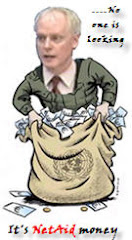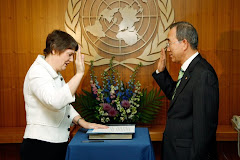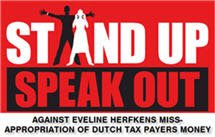Why NGOs prefer bad news

And now for some good news out of Africa. Poverty rates throughout the continent have been falling steadily and much faster than previously thought, according to the National Bureau of Economic Research. The death rate of children under five years of age is dropping, with “clear evidence of accelerating rates of decline,” according to The Lancet. Perhaps most encouragingly, Africa is “among the world’s most rapidly growing economic regions,” according to the McKinsey Quarterly.
Yet US journalism continues to portray a continent of unending horrors. Last June, for example, Time magazine published graphic pictures of a naked woman from Sierra Leone dying in childbirth. Not long after, CNN did a story about two young Kenyan boys whose family is so poor they are forced to work delivering goats to a slaughterhouse for less than a penny per goat. Reinforcing the sense of economic misery, between May and September 2010 the ten most-read US newspapers and magazines carried 245 articles mentioning poverty in Africa, but only five mentioning gross domestic product growth.
Reporters’ attraction to certain kinds of Africa stories has a lot to do with the frames of reference they arrive with. Nineteenth century New York Herald correspondent Henry M. Stanley wrote that he was prepared to find Zanzibar “populated by ignorant blacks, with great thick lips, whose general appearance might be compared to Du Chaillu’s gorillas.” Since the Biafran War, a cause célèbre in the West, helped give rise in the late 1960s to the new field of human rights, Western reporters have closely tracked issues like traditional female circumcision. In the 1980s, a famine in Ethiopia that, in fact, had as much to do with politics as with drought, set a pattern of stories about “starving Africans” that not only hasn’t been abandoned, but continues to grow: according to a 2004 study done by Steven S. Ross, then a Columbia journalism professor, between 1998 and 2002 the number of stories about famine in Africa tripled. In Kenya, where I was a Peace Corps volunteer in the late 1960s and where I returned to live four years ago, The New York Times description of post-election violence in 2007 as a manifestation of “atavistic” tribalism carried echoes of Stanley and other early Western visitors.
But the main reason for the continued dominance of such negative stereotypes, I have come to believe, may well be the influence of Western-based non-governmental organizations (NGOs) and international aid groups like United Nations agencies. These organizations understandably tend to focus not on what has been accomplished but on convincing people how much remains to be done. As a practical matter, they also need to attract funding. Together, these pressures create incentives to present as gloomy a picture of Africa as possible in order to keep attention and money flowing, and to enlist journalists in disseminating that picture.
Africans themselves readily concede that there continues to be terrible conflict and human suffering on the continent. But what’s lacking, say media observers like Sunny Bindra, a Kenyan management consultant, is context and breadth of coverage so that outsiders can see the continent whole—its potential and successes along with its very real challenges. “There are famines; they’re not made up,” Bindra says. “There are arrogant leaders. But most of the journalism that’s done doesn’t challenge anyone’s thinking.”
Over the past thirty years, NGOs have come to play an increasingly important role in aid to Africa. A major reason is that Western donors, worried about government corruption, have channelled more funds through them. In the mid-1970s, less than half a dozen NGOs (like the Red Cross or CARE) might operate in a typical African country, according to Nicolas van de Walle, a professor of government at Cornell, but now the same country will likely have 250.
This explosive NGO growth means increasing competition for funds. And according to the head of a large US-based NGO in Nairobi, “When you’re fundraising you have to prove there is a need. Children starving, mothers dying. If you’re not negative enough, you won’t get funding.” So fierce is the competition that many NGOs don’t want to hear good news. An official of an organization that provides data on Somalia’s food situation says that after reporting a bumper harvest last year, “I was told by several NGOs and UN agencies that the report was too positive.”
Rasna Warah, a Kenyan who worked for UN-Habitat before leaving to pursue a writing career, says that exaggerations of need were not uncommon among aid officials she encountered. “They wanted journalists to say ‘Wow.’ They want them to quote your report,” she says. “That means more money for the next report. It’s really as cynical as that.”
Western journalists, for their part, tend to be far too trusting of aid officials, according to veteran Dutch correspondent Linda Polman. In her book The Crisis Caravan, she cites as one example the willingness of journalists to be guided around NGO-run refugee camps without asking tough questions about possible corruption or the need for such facilities. She writes, “Aid organizations are businesses dressed up like Mother Teresa, but that’s not how reporters see them.”
Pushed and pulled by slashed budgets and increased demands, journalists are growing increasingly reliant on aid groups. Sometimes that involves not just information or a seat on a supply plane, but deep involvement in the entire journalistic process.
In an online essay written in 2009, Kimberly Abbott of the International Crisis Group discussed a 2005 Nightline program on Uganda that her NGO helped to produce and fund. It was hosted by actor Don Cheadle, the star of Hotel Rwanda. Nightline’s Ted Koppel explained in his introduction, as retold by Abbott: “Cheadle wanted his wife and daughters to get a sense of the kind of suffering that is so widespread in Africa. The International Crisis Group wanted publicity for what is happening in Uganda. And we, to put it bluntly, get to bring you a riveting story at a greatly reduced expense.” According to Abbott, “versions of such partnerships are happening now in print and broadcast newsrooms across the country, though many are reluctant to discuss them too openly.”
Daniel Dickinson, a former BBC reporter who is now a communications officer for the European Union in Nairobi, has seen the impact of technology and economics on reporting on Africa first-hand. “The big difference in the past five to ten years is the expansion of the Internet,” he says. “Journalists have got to feed these animals. Add to that the financial crash, and more and more internationals are taking the content we offer them.”
Ben Parker, co-founder and head of IRIN, a news agency that is part of the UN Office for the Coordination of Humanitarian Affairs, admires Dickinson’s success. “He does stories and they’re picked up whole,” Parker says. IRIN itself can point to many similar successes in finding takers for its stories on aid projects. “The Western media won’t reprint us verbatim,” he says. “But some plagiarize.”
Lauren Gelfand, a correspondent for Jane’s Defence Weekly who is based in Nairobi, says most reporters she knows string for three or four news organizations to make ends meet, and can’t afford to do time-consuming stories. She saw the effect when she took a year off from journalism to work for Oxfam. “If reporters were going to cover a development story it had to be easy,” remembers Gelfand, noting that the simplest sell was a celebrity visit to an aid project.
Gelfand says that her Oxfam experience helped her to understand just how much attention ngos put on getting their story told. “All the talking points are carefully worked out…. It’s a huge bureaucracy and there are as many levels of control as in any government,” she says of Oxfam, adding that many NGOs are reluctant to cooperate with media unless they know they’ll be shown in a positive light.
To be fair to the NGOs, Gelfand says, “It’s easier to sell a famine than to effect real, common-sense policy change.” And, she says, she continues to believe that most aid workers do what they do because they want to make a difference. Nonetheless, “A lot of what Oxfam does is to sustain Oxfam.”
Stories featuring aid projects often rely on dubious numbers provided by the organizations. Take Kibera, a poor neighborhood in Nairobi. A Nexis search of major world publications found Kibera described as the “biggest” or “largest” slum in Africa at least thirty-four times in 2004; in the first ten months of 2010 the claim appeared eighty-three times. Many of those stories focused on the work of one of the estimated 6,000 or more local and international NGOs working there, and cited population figures that ranged as high as one million residents. Recently, however, the results of Kenya’s 2009 census were released: according to the official tally, Kibera has just 194,269 residents. In 2010, Rasna Warah wrote in the Daily Nation, a Kenyan paper, that while working for the Worldwatch Institute, an NGO, she had published inflated population estimates using UN-Habitat data, despite knowing there was no consensus on the numbers among her former colleagues at the organization. Sometime after 2004, she wrote, population estimates for Kibera started to rise, and “Before we knew it, the figure spread like a virus.” She added, “The inflated figures were not challenged, perhaps because they were useful to various actors…. They were particularly useful to NGOs, which used them to ‘shock’ charities and other do-gooders into donating more money to their projects in Kibera.”Questionable figures of another sort are to be found in reports on the United Nations Millennium Development Goals, a series of targets on poverty reduction and other measures of well-being. UN and NGO officials routinely describe Africa as failing to meet the goals, and the press routinely writes up this failure.
But some experts, among them Jan Vandemoortele, one of the architects of the MDGS, have expressed concern that the goals are being misused. He wrote in 2009 that the MDGS were intended as global targets, but have been improperly applied to individual countries and regions. “It is a real tragedy when respectable progress in Africa is reported as a failure by international organizations and external observers,” Vandemoortele wrote, voicing the suspicion that particular measurements have been selected “so as to present Africa as a failure, solely to gain support for a particular agenda, strategy, or argument.”
Nonetheless, when the UN met in September, The Associated Press quoted UN Secretary-General Ban Ki-moon as saying, “Many countries are falling short, especially in Africa,” while the Los Angeles Times quoted an Oxfam report as saying, “Unless an urgent rescue package is developed to accelerate fulfillment of all the MDGS, we are likely to witness the greatest collective failure in history.”
The consequences of skewed or incomplete reporting on Africa are not just a disservice to readers but also have the potential to influence policy. “The welfare model [of Africa] is still dominant on the Hill and in Hillary Clinton’s world,” according to van de Walle. Among corporate officials, says Catherine Duggan, an assistant professor at Harvard Business School, the perception is still that “Africa is where you put your money once you’ve made it somewhere else.” Moreover, such reporting is demoralizing to Africans working for change. Martin Dawes, a unicef regional chief of communication for West and Central Africa, says that when there is a disaster, journalists “come to us as aid workers but often don’t talk to the government, which is often what we’re working through. It means that the chances for Africans to show an engaged response is limited. They are written out of their own story.”
Even with shrinking resources, journalists can do better than this. For a start, they can stop depending so heavily, and uncritically, on aid organizations for statistics, subjects, stories, and sources. They can also educate themselves on how to find and interpret data available from independent sources. And they can actively seek out stories that deviate from existing story lines.
But in the end, it will probably take sustained economic progress to break the current mold. Sunny Bindra, the Kenyan management consultant, recalls that in the 1980s, “Japan got attention because it was whacking the US. It’s the same with India and China now.” Until that happens, a sick African woman in labor will continue to be treated as poverty porn, and most Africans will have to starve in order to make it onto the evening news.
This article was adapted from a paper (pdf) written for Harvard’s Joan Shorenstein Center on the Press, Politics and Public Policy.
















































No comments:
Post a Comment